The Széchenyi Chain Bridge: History, Engineering, and Practical Visit Details
Budapest's Chain Bridge crosses the Danube River and connects the two sides of the city that used to be separate. This is the bridge that first linked Buda and Pest together, and it's become one of Europe's most famous landmarks. When Count István Széchenyi pushed for this project back in the 1830s, he wanted more than just a way to cross the river. He had big plans to connect these two different areas and change Hungary completely.
The bridge is 375 meters long and when it was built, that center span was one of the biggest in the world. Those stone towers look like old castles rising up from the water, and four stone lions sit at each end like guards. We always tell people to walk across at sunrise when the light hits the water just right, or come back at night when all the lights make it look magical. Either way, this bridge gives you the perfect introduction to what makes Budapest so special.
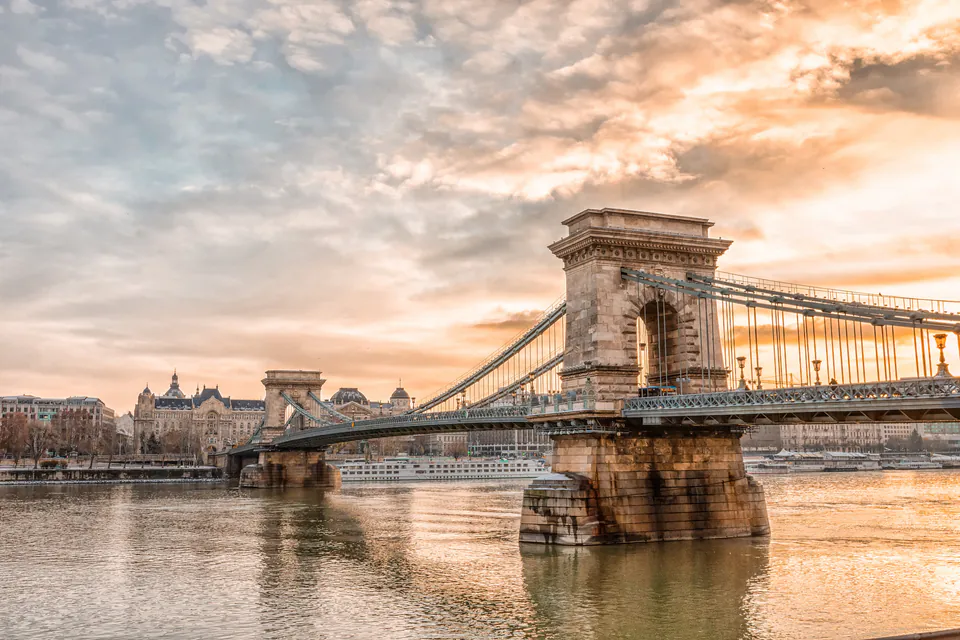
How One Man's Tragedy Changed Budapest Forever
This bridge exists because Count István Széchenyi missed his father's funeral. In December 1820, ice blocked the Danube completely and he got stuck on the Pest side for a whole week. He couldn't get across to attend the funeral in Vienna, and that really got to him. We can only imagine how frustrated and heartbroken he must have been.
Széchenyi had traveled to England and seen what they were doing with bridges there, especially the one at Hammersmith in London. So in 1832, he started the Bridge Association and brought in English engineer William Tierney Clark to design something that would make sure this never happened to anyone else. The project needed money from all over Europe, and a Greek-Hungarian banker named Georgios Sinas helped fund the whole thing.
They started building in 1840 with Scottish engineer Adam Clark running the construction. Funny thing is, Adam Clark wasn't related to William Tierney Clark at all, just happened to have the same last name. All the iron pieces were made in England and shipped by boat to Hungary. On July 28, 1840, they drove the first pile into the Buda side, and that started ten years of really hard work.
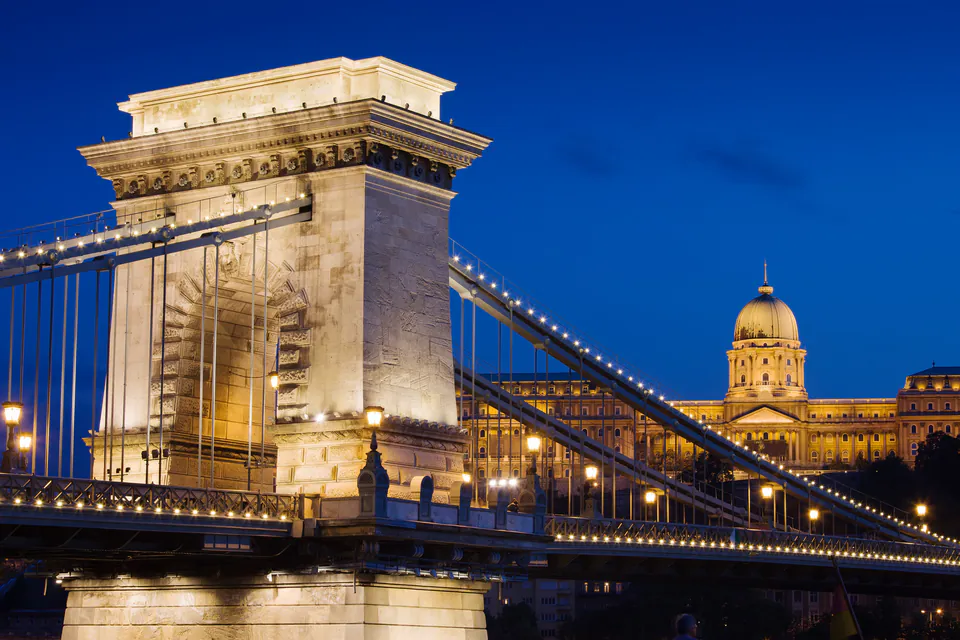
When This Bridge Was High-Tech
When the Chain Bridge opened on November 20, 1849, it was basically the latest technology. This was cutting-edge stuff back then. The whole thing stretched 375 meters across the Danube, and that center part was one of the longest spans anywhere in the world at the time. Those iron chains anchored to huge stone towers could handle horse carriages, people walking, and all the traffic from a city that was growing fast.
But it wasn't just about engineering. William Tierney Clark had already built the Marlow Bridge over the Thames, but this Budapest version had Hungarian touches that made it special. The stone towers mix classical and Gothic styles, and they put the Hungarian coat of arms right on them, plus the family crests of Széchenyi and Sina. All the cast-iron decorations and lamp posts made it look really elegant.
Three years later, they added the most famous part: four huge stone lions carved by János Marschalkó. These things weigh 10 tons each and are made from limestone. There's this old story that Marschalkó jumped in the Danube because he forgot to carve tongues on the lions. That's not true though. The tongues are there, you just can't see them easily because they're under the lions' jaws.
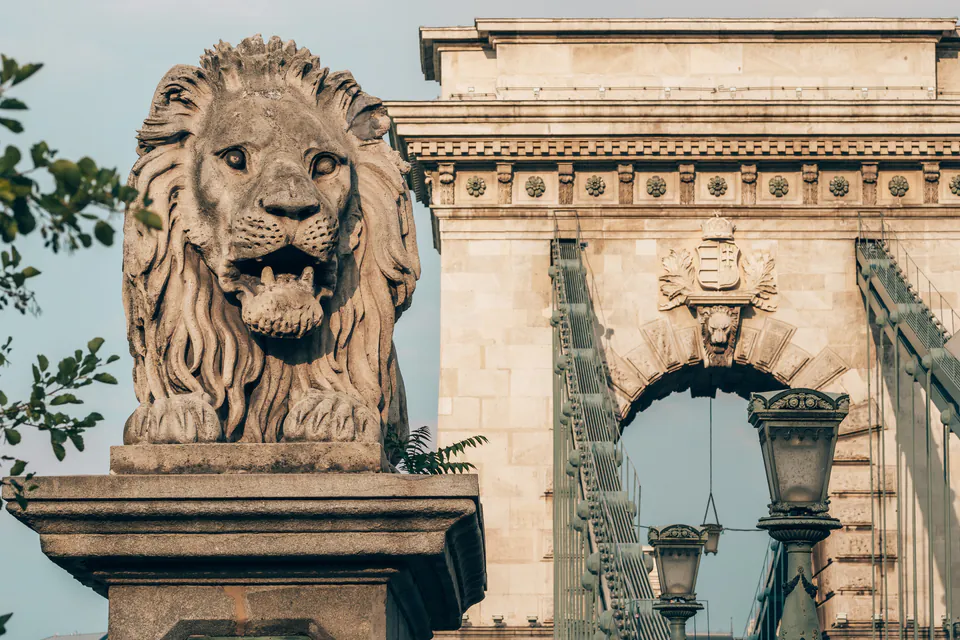
War, Destruction, and Rebuilding
The Chain Bridge has been through some really tough times. During the 1848 Hungarian Revolution, Adam Clark actually saved the bridge by flooding the chain chambers when imperial troops wanted to blow it up. Pretty smart thinking that kept this important piece of infrastructure from getting destroyed during one of Hungary's most chaotic periods.
Between 1913 and 1915, they had to make the bridge stronger to handle more traffic. But World War II was devastating. On January 18, 1945, German forces blew up the Chain Bridge along with every other bridge crossing the Danube in Budapest. Only those stone towers were left standing, like they were mourning what they'd lost.
We're always amazed at how quickly they started rebuilding after the war. This bridge meant so much to Hungarian identity that they couldn't wait. The engineers actually pulled 70% of the original chains out of the Danube and used them in the new bridge. When we learned that fact, it really hit us how determined people were to keep the original spirit alive. The new Chain Bridge reopened on November 20, 1949, exactly 100 years after the first one opened. That timing wasn't an accident.

No More Cars: The Bridge Gets a New Life
The Chain Bridge's newest chapter started in March 2021 when they closed it for the first big renovation since World War II. This took two years and they had to fix structural problems while keeping all the historical parts exactly right. They replaced the road surface but were super careful with the original architectural details. Those four famous lions got taken to special workshops where experts restored them piece by piece.
They also put in modern LED lights that make the bridge look incredible at night and can change colors for special events and celebrations. It's pretty cool how they balanced keeping the historical look with making it more sustainable.
But the biggest change is that private cars can't use the bridge anymore. It's now just for buses, taxis, bikes, and people walking. We think this was a really bold decision that makes the whole experience much better. You can actually hear yourself think now when you're walking across, and you can take your time looking at all the details and views without worrying about traffic.

All the Beautiful Details You Should Notice
The Chain Bridge really shows how you can make something that works great and looks amazing at the same time. Those massive iron chains anchor to stone towers that go up 48 meters above the Danube. The towers themselves are pretty incredible, built from limestone blocks with classical details that make them look like medieval fortresses.
The bridge deck is 14.8 meters wide. Originally they designed it for horse-drawn carriages and people walking. All the cast-iron decorative stuff shows that Victorian style that was popular when they built it. The Hungarian coat of arms on both towers shows national pride, and the Széchenyi and Sina family crests recognize the people who made it happen.
Those elegant lamp posts run along the whole length, and their curves go perfectly with the overall design. The modern LED upgrade keeps the historical look but uses way less energy and lets them do those spectacular color displays for special occasions throughout the year.
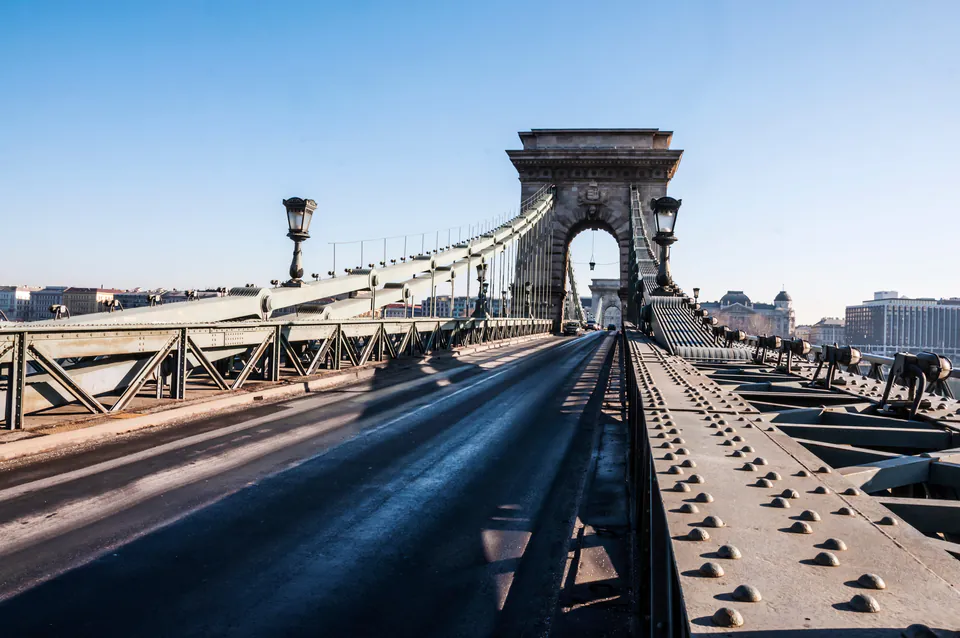
Walking Across: What to Expect
Walking the Chain Bridge is one of the best things you can do in Budapest. The sidewalks give you clear views in every direction, so if you like taking photos, this is perfect. From the middle of the bridge, you can see the Hungarian Parliament building rising up on the Pest side, and Buda Castle sitting on top of the hill on the other side.
We usually tell people it takes about 10-15 minutes to walk across at a normal pace, but most visitors spend way longer stopping for photos and just taking in the views. Early morning has the softest light and fewer people around. Sunset is when the whole scene turns golden and makes the Parliament building glow like something from a fairy tale. At night with all the lights, it's completely different but just as magical.
You should think about the weather before you go. The bridge can get pretty windy, especially in winter, and those stone surfaces get slippery when it's wet. We learned this the hard way during a rainy April visit when we nearly slipped while trying to get the perfect shot. Wear good shoes, especially if you want to explore the areas around the bridge afterward. The bridge stays open 24 hours, so you can visit whenever works for you.
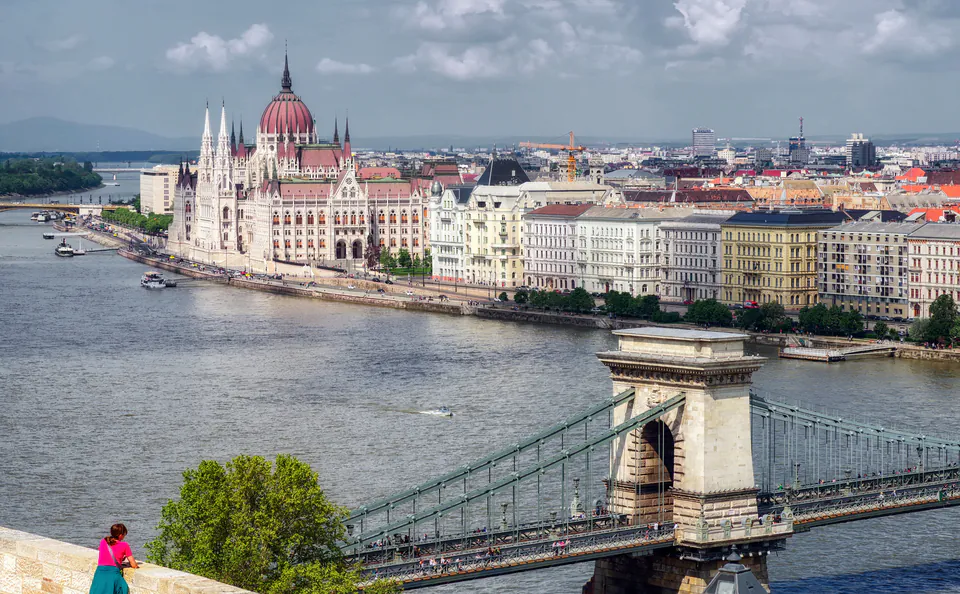
Connecting Two Different Worlds
The Chain Bridge does more than just cross the river. It connects two completely different parts of Budapest. On the Pest side, where the bridge meets Széchenyi István Square (they used to call it Roosevelt Square), you're in the commercial and political center. You'll find the Hungarian Academy of Sciences, the beautiful Art Nouveau Gresham Palace (now a Four Seasons Hotel), and you can easily walk to Váci Street for shopping.
On the Buda side, the bridge connects to Clark Ádám Square, named after that Scottish engineer who supervised construction. This square is your gateway to Castle Hill, and there's a funicular that takes you up to the royal palace complex. The square also has the Zero Kilometre Stone, which is where they measure all Hungarian road distances from.
The bridge sits in a perfect spot for exploring Budapest's main attractions. From either end, you can walk to thermal baths, museums, restaurants, and shopping areas. The Danube Promenade runs along both sides of the river, so you can keep walking and enjoy continuous views of the river and all the beautiful architecture.
Getting the Perfect Photos
The Chain Bridge is one of the most photographed bridges in the world, and we've figured out the best spots to capture its beauty. From the bridge itself, the best photos face north toward the Parliament building and south toward Gellért Hill where you can see the Liberty Statue. The center of the bridge gives you the most dramatic shots, with those stone towers framing everything perfectly.
For photos of the bridge from outside, there are several great spots. The Danube Promenade on both sides gives you classic angles, and if you go up to Buda Castle, you get elevated views that show the bridge's full span against the city. The Fisherman's Bastion takes a bit of walking uphill, but the views from there are some of the most iconic Chain Bridge shots you can get.
Timing makes a huge difference for lighting. We always recommend the golden hour just after sunrise and before sunset because you get that warm, flattering light that makes both the bridge's stonework and surrounding architecture look amazing. Blue hour, right after sunset, creates dramatic silhouettes while the bridge's lights start to glow against the darkening sky.
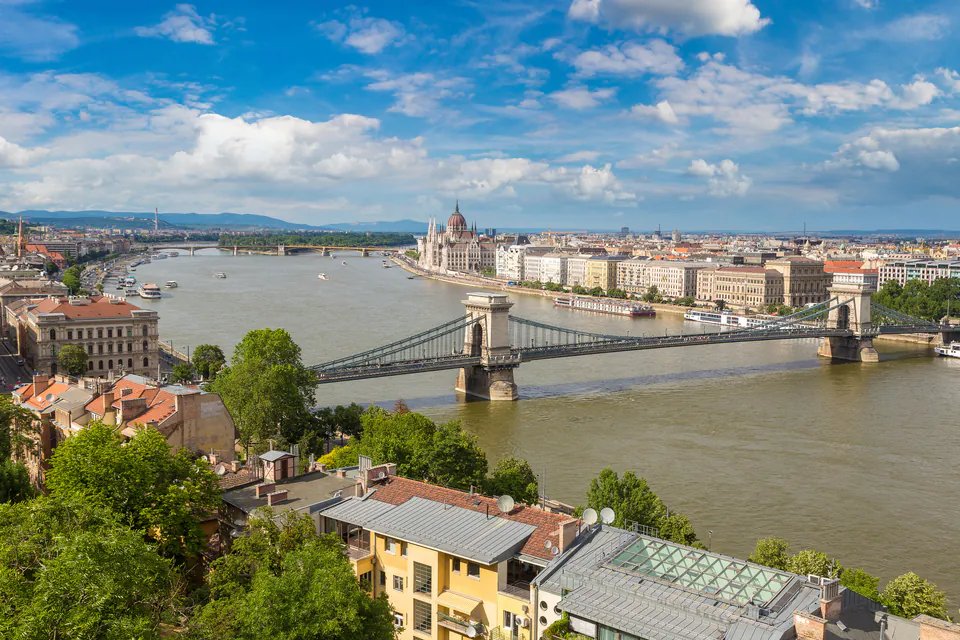
Important Dates in Chain Bridge History
Chain Bridge Historical Timeline
| Year | Historical Event |
|---|---|
| 1820 | Count Széchenyi delayed by ice, inspiring bridge concept |
| 1832 | Bridge Association established, project planning begins |
| 1838 | William Tierney Clark finalizes three-arch design |
| 1840 | Construction begins, first pile driven on Buda side |
| 1849 | Official opening on November 20 |
| 1852 | Stone lions installed by János Marschalkó |
| 1873 | Buda and Pest officially merge, creating Budapest |
| 1898 | Formally named Széchenyi Chain Bridge |
| 1913-1915 | Major reconstruction to strengthen structure |
| 1945 | Destroyed by German forces during WWII retreat |
| 1947-1949 | Post-war reconstruction using original materials |
| 1949 | Reopening exactly 100 years after original inauguration |
| 2021-2023 | Comprehensive renovation and car-free conversion |
How to Visit Today
After the 2023 renovation, the Chain Bridge works under new rules that make visiting much better. Private cars can't use it anymore, but public buses, taxis, motorcycles, and bikes share the road with dedicated lanes. This no-car policy has cut down noise and air pollution so much, making it much more pleasant for people walking.
The bridge connects two major transport hubs. On the Pest side, Széchenyi István Square has access to multiple metro lines, tram routes, and bus connections. The Vörösmarty Square metro station (Line 1) is just a five-minute walk away. On the Buda side, Clark Ádám Square has several bus routes and you can get right to the Castle Hill Funicular.
Walking across is free and you can do it 24 hours a day. The bridge has wide sidewalks on both sides, but the upstream (northern) walkway usually has better views and photo opportunities. During busy tourist seasons, we recommend going early morning or late evening when there's more space and better lighting for photos.
Sometimes they close the bridge temporarily for special events, filming, or maintenance work. They usually announce these closures ahead of time through official Budapest tourism channels and the Budapest Transport Center (BKK) website. Big events like New Year's Eve or National Day celebrations might affect access, so it's smart to check current conditions before you visit.